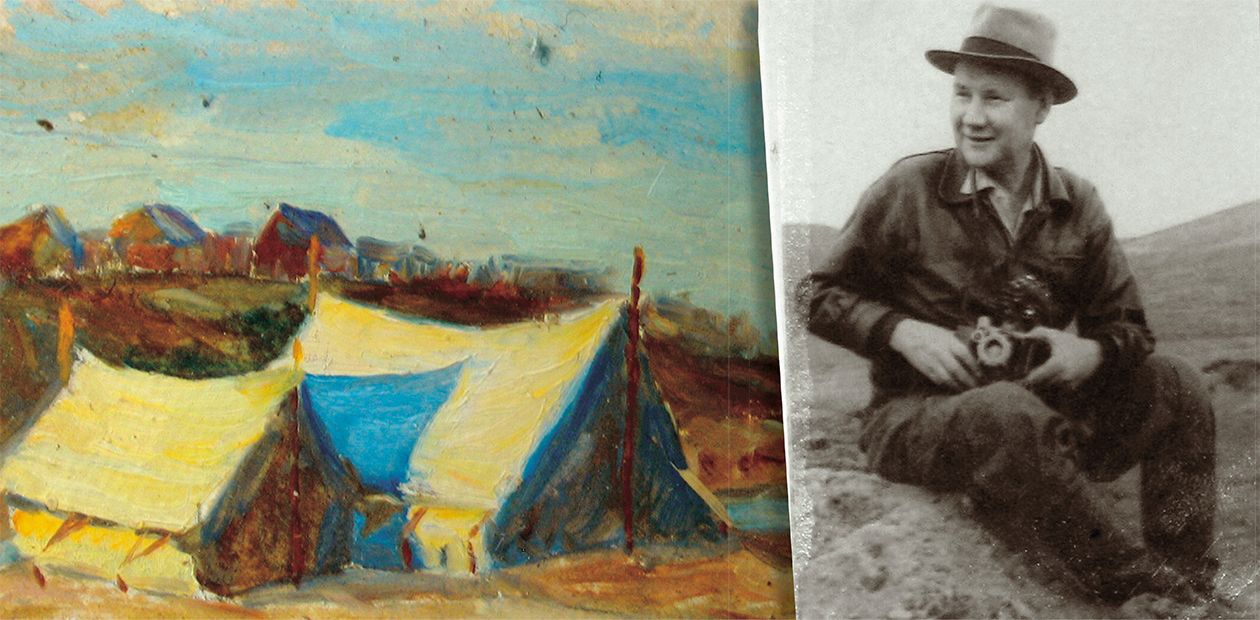Keep Forever. The First Publication from A.P. Okladnikov's Personal Archives
Unpublished archives of scholars have always presented an even greater interest than their published works since they allow insight into the sanctum, the creative laboratory of the researcher
The archives of Aleksei Okladnikov that Elena Okladnikova, his daughter, transferred to the St-Petersburg branch of the RAS Archives are so large that if the folders were stacked one upon the other, the pile would be the height of a fourteen-storied building. I was lucky to sort out the archives and prepare the materials for registration and keeping. The more I plunged into the materials, the more puzzled I became: how could one person attain so much?
I spent my school and university years in Vladivostok, where every junior pupil was familiar with Okladnikov’s name. The name of this outstanding historian, archaeologist, and ethnographer, who discovered East Siberia, Russian Far East, and Central Asia anew, was mentioned at every session of our archaeological circle. In those days, Okladnikov was a myth. Now, when I am involved with the study of his archives, I am getting to know him as a person. I watched him turn from an Olympian, a god, into a great indefatigable toiler.
Aleksei OKLADNIKOV (1908–1981) is an archaeologist, historian, and ethnographer, Academician of the USSR Academy of Sciences, Hero of Socialist Labor. In 1938–1961 he worked at the Leningrad Department of the Institute of Archaeology, USSR Academy of Sciences. Since 1961, was head of the Department of Humanitarian Research at the Institute of Economics of the Siberian Branch of the USSR Academy of Sciences (SB AS USSR); since 1966, director of the Institute of History, Philology and Philosophy, SB AS USSR; since 1962, professor and head of the Chair of History at Novosibirsk University. Major interests: history of primitive society; primitive culture; history of Siberia, the Russian Far East, and Far North from the ancient times to the 18th century.From his archives appears an image far from that of an armchair scholar. Okladnikov made notes of his observations and ideas on scraps of paper, blotting paper, and old receipts in violet (“pupil’s”) ink and lead pencil. The wartime folders are particularly abundant in “notes on the scraps”. It is amazing but the hard times of the forties appeared to be the most productive.
Plenty of legends existed among archaeologists, and Okladnikov’s phenomenal luck was one of them. Each of his expeditions ended up with some unique finds; and, as a rule, people could not resist the temptation to come up with some half-mystical explanation of his success. But the point was not mysticism but Okladnikov’s capacity for work that at times bordered on obsession. Okladnikov tried to do everything himself admitting no one but his nearest “companions-in-arms” to the cause of his life. He kept field journals, made sketches, photographs, descriptions, and drawings of the finds. Vera Zaporozhskaya, Okladnikov’s wife, who followed her husband in all his expeditions, was one of his companions-in-arms. The archives contain lots of her wonderful watercolors, precise drawings of the archaeological finds, and friendly and humorous caricatures of easily recognizable Aleksei Okladnikov and his colleagues.
Now, years after, it is even hard to imagine how much courage and endurance it took to serve history and archaeology with such dedication, not to mention the hard conditions the scholars found themselves in. At the beginning of their travel along the roads (or, rather, lack of them) of East Siberia and the Russian Far East, the whole luggage of Aleksei Okladnikov and his wife consisted of a couple of field shirts and a change of underwear. Besides, one should not forget about the main thing, the “metallic taste of the time” so clearly felt in the 1930s and 1940s.
Materials from the scholar’s archives contain evidence to it. Here is a brief excerpt from the shorthand record of the meeting at which the first volume of Okladnikov’s History of Yakutia was discussed. The meeting was held on March 6, 1950 in Moscow, at the Department of History and Philosophy, USSR Academy of Sciences.
A large share of Okladnikov’s archives is notes written on scraps of bills and receipts, between the lines of newspaper and magazine articles, which reflected not only the intense and incessant work of his mind but also the shortage of paper“G. P. Basharin:
Such are the directives of Leninism, the Central Committee of our Party concerning the science of history taken in their most generalized form. I think we ought to discuss the first volume of History of Yakutia in the light of these, solely correct, true scientific propositions.
A. P. Okladnikov:
Comrade Basharin says that I am idealizing the primitive hunter for mammoths to the detriment of present-day kolkhoz life of Yakutia. This is no more than a demagogic phrase. Without a doubt, I committed a certain inaccuracy when I said that the first Paleolithic tribes led a more solid life than our forest hunters of the tundra. He is right here, but why ascribe to me what I did not mean to say and did not say? In any case, it had nothing to do with kolkhoz life.”
Even such a short fragment suffices to show what arguments Okladnikov had to confute in the times when any discussion of a scholarly work could easily turn into condemnation of its author.
Yet, there were some almost funny moments (in case of an unfortunate turn of events, though, they could become a great disaster). In 1946, Okladnikov wrote in his autobiography attached to his application to join the Communist party: “When I was in Irkutsk, I was expelled from the Komsomol (Young Communist League), and two weeks later I was restored. The ground for the expulsion was the official statement submitted by Kazakova, the former director of the museum. The statement alleged that I had brought to the museum ‘Saint Sene[sii]’s relics’ from the liquidated Voznesensk monastery. Sene[sii], whose mummy was really well preserved and was of interest from the academic point of view, was not canonized, therefore the fears of Kazakova that she might be held responsible for the delivery of the mummy to the museum were not substantiated. A clergyman of a high order specially invited to the museum confirmed it. Yet this misfortune made a deep and long-last impression on me. Later on, Kazakova was unmasked as an enemy of the people.”
One should think that some letters of his friends and colleagues also made a deep impression on his mind. These were the letters from the people who had vanished in the depths of correctional labor camps in the north and from those who had survived by a miracle there. Such letters are present in abundance in the scholar’s archives, as well as letters from his disciples, assistants, and residents of the places where Okladnikov happened to conduct excavations. Almost all of them begin with the words, “Dearest Aleksei Pavlovich”.
If Okladnikov’s correspondence is published one day, it will teach a good lesson to young archaeologists, not only in what concerns one’s attitude to work, but also as far as human relations are concerned. Although Okladnikov was a distinguished scholar (which means he did not have a minute to spare), he found time to answer even to those who, to all appearances, were absolutely “of no use” to him. His correspondence with his childhood friend Alexander Lobanov preserved in the post-war folders can tell a lot about Okladnikov. The two friends lost sight of each other in their youth; each suffered a lot of hardships — Lobanov found himself in Kolyma in 1937. After the war the former classmates met, purely by chance, and had kept in touch ever since. At the end of the 1940s, Lobanov wrote to Okladnikov, “The main thing that I notice in you and that beautifies your image of a Soviet scholar is your tireless research activity and originality both in style and methods of investigation…Do you remember when at school you were reading me about Przhevalskii’s trips to Mongolia? It appears that you found your road to archaeology at that time.”
Aleksei preserved his childlike enthusiasm for science and travel to his last days. Resting on his laurels went against his principles, which is evidenced by his notes made in the libraries, photocopies of journal articles, index cards with names of interesting monographs and learned works — not only on archaeology and history — that make up a considerable portion of Okladnikov’s archives. Among these papers we find a library request form for a book on drawing techniques. At the age of fifty, Okladnikov worked like a young postgraduate student.
Sorting out the archival materials, I was wondering how it was possible to get along with such a person. What was it like to be permanently by the side of a man untiringly advancing forward, seeing in research if not the only, then, without any doubt, the main purport of life? It was an honor and joy to learn from him and work with him. Staying beside such an outstanding person means almost for sure remaining in his shade, whereas leaving him means losing the precious opportunity of doing top level research. The general tone of the Okladnikov’s correspondence with his younger colleagues is friendly and easy. Yellow sheets of paper that are turning fragile with time have brought to us the live and warm gratitude of the disciples towards the Teacher.
One may have an impression that Okladnikov did not allow any private life for himself. His archives contain very few family photographs, almost no letters from his wife or drawings by his young daughter. But why should Vera, his wife, have written letters to him if she was by his side for the major part of her life? Plenty of drawings and watercolors that reflected their modest life during expeditions, Siberian majestic and rigorous scenery, and the archeological finds were her contribution to the expedition folders. These illustrations turned field reports into invaluable personified documents narrating about the people whose whole life belonged to archaeology. And in that life there was no place for any division into the private and the rest.
The published part of the scholarly heritage left by Okladnikov is merely the visible top of an iceberg. Its bigger and more interesting part still remains hidden under water, in endless work notes, tables, and schemes that helped Okladnikov in systematizing the incredible volume of information that his memory kept, and in scraps of paper scribbled all over with pencil notes. To these we should add his lectures, unpublished papers, countless drafts, which give us an exciting opportunity to follow the evolution of his thoughts and offer the chance of visiting the scholar’s creative workshop.
The fourteen stories of the archives contain Okladnikov’s works and life. Preparation of at least part of these materials for publishing would be hard but gratifying work, and there is no doubt some researchers would be willing to take it upon themselves. I hope that it happens in the nearest future, because time flies so fast, and we do not have much of it left. Aleksei Okladnikov managed to perform everything he was destined for in the period of life measured to him. And what about us? Will we be able to become worthy keepers of his heritage?











